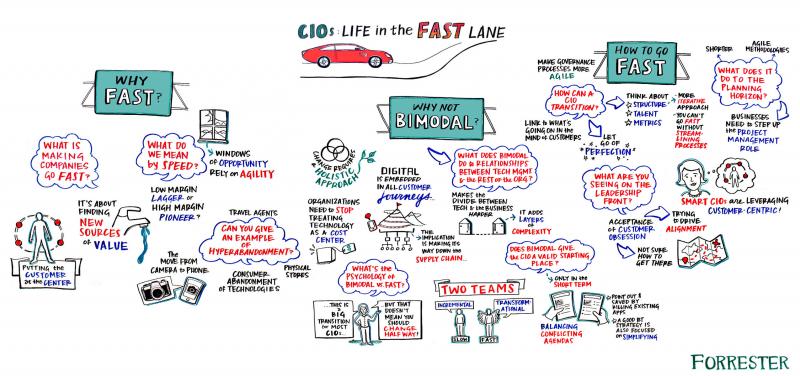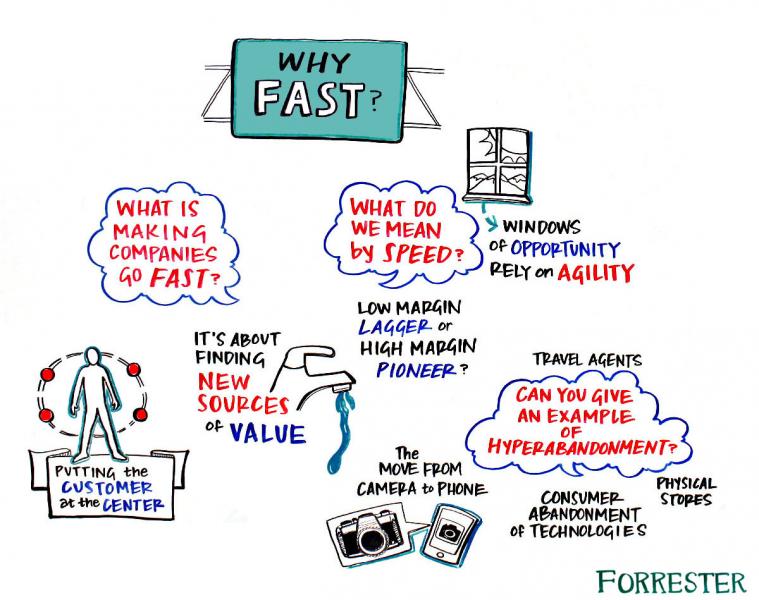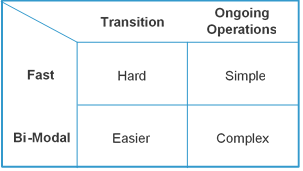CIOs: Life In The Fast Lane
The pace of business – heck, the pace of life, gets faster and faster. Faster processing, faster delivery, faster innovation – and faster adoption and abandonment of that innovation — is the reality we all live in today.
Leaders run fast businesses to win and to stay apace or in front of dynamic customers and disruptive competitive forces. They can’t out-slow the competition. Speed is the only option.
I had the pleasure of participating in a webinar panel to discuss what it means to work at one speed (fast) versus at two speeds as bimodal IT advocates. We discussed why businesses are forced to go fast, the reality and downside of a bimodal IT strategy, and the strategies and approaches to winning based on speed. Here is a quick view of the ground we covered.
Why fast?
The first part of our discussion focused on the factors that are making companies operate at fast speeds. Broadly, it comes down to three factors:
- Hyper-adoption and hyper-abandonment: Customers are willing to rapidly try, use, and then possibly discard content, apps, and services in a world of seemingly infinite choices and extremely low cost to entry and exit. This dynamic fundamentally changes – speeds up – what it means to “have” a customer.
- Eroding loyalty structures: The classic view of brand loyalty is getting more volatile. Customers have the means to find the best deal, to stay in front of new fashions and gadgets, and are swayed by the rapid tos and fros of social suggestions. This dynamic changes what it means to persistently win the battle for heart, mind, and spend.
- Normalizing digital disruption: It used to be that scrappy start-ups could change markets. Disruption was annoying and sometimes impactful, but it was limited. Those days are over. Traditional market leaders can now move fast and become disruptors themselves. This new normal course of fast markets puts moderately-paced and slow firms on their heels and in trouble.
Why not bimodal IT?
Bimodal IT operates at two speeds: fast for digital and slow for traditional IT. In essence, it argues that digital technologies address fast market dynamics, and traditional IT – the technology and the people – are insulated and free to follow the (slow) status quo. We think that is fool’s gold.
- Minimal customer value: Virtually all technologies directly or indirectly deliver customer value. Supply chain systems are vital for time-to-market and fulfillment. Finance systems must be able to configure price changes and SKU tracking to enable the firm to operate at the pace of the market. Arguing only digital goes fast argues that a digital veneer is all that is needed.
 Unnecessary complexity: One of the great hooks for bimodal IT is it avoids moving all teams to a fast mode. Essentially, it’s easier than a full business technology (BT) transformation. But that short-term ease introduces extraordinary complexity into ongoing operations—running two teams with two cultures with different incentives, different cultural norms, different talent management approaches, etc.
Unnecessary complexity: One of the great hooks for bimodal IT is it avoids moving all teams to a fast mode. Essentially, it’s easier than a full business technology (BT) transformation. But that short-term ease introduces extraordinary complexity into ongoing operations—running two teams with two cultures with different incentives, different cultural norms, different talent management approaches, etc.
- Disengaged business partners: IT’s longstanding reputation is slow: critical and fast moving technology requirements are placed into queue’s that are paced at the speed of traditional IT, not the speed of the business. Intentionally codifying slow – in any part of the CIO’s team – is a leadership mistake that delivers a clear message that the CIO doesn’t understand the business environment.
How to go fast.
Shifting to fast is not easy, but leaders are charging forward. The strategy is driven by shifting cultural norms, people, and the operating model in one cohesive move.
- Place the customer as the north star of change: Telling unsure teams that fast is the goal won’t move them. Giving them real insights into the realities of today’s customers and disruptors puts a face and imperative to fast – it affirms the customer-obsessed culture needed in today’s market.
- Lean on (the right) people: Not everyone will want to be or excel at being fast. CIOs will have to put in recruiting, learning, and incentive programs to shift existing teams to fast. They’ll also likely need to quickly source talent in the outside market to strengthen the team. The CIOs team must lead the charge to avoid internal discord that destroys teams and performance.
- Redesign operations for speed: Shifting to fast means reengineering processes and, in some cases, changing the philosophy of process design. Traditional IT-centered processes are designed to minimize risk because that was what was needed by the business. Not today. Process design is now shifting to a “learn fast” model where fast becomes more important than perfect.
No one argues that responding to a customer-led market where disruption is normal is going to be easy. It is hard work – or better stated – it is a hard transition that yields a more powerful and simpler business. Done fully, the CIO will shine. Done partially, the CIO will flounder and fade. It’s time to fully embrace life in the fast time.
If you missed our live webinar, you can listen to the on-demand version at any time. And for more information on how to move at the speed of customers and business, download our complimentary report, or read the full research report “The False Promise Of Bimodal IT.”
